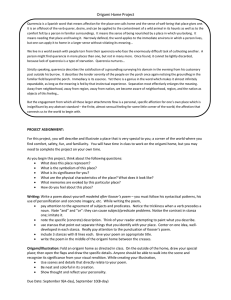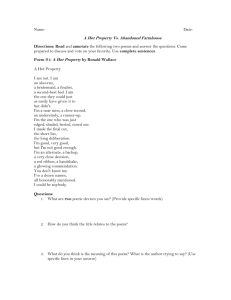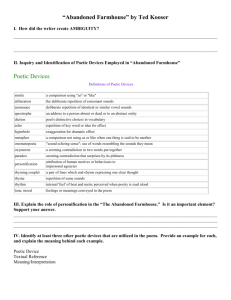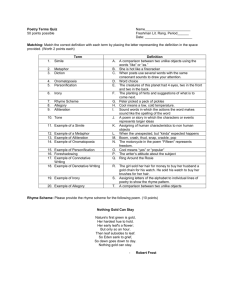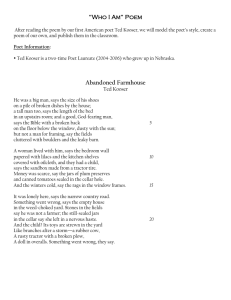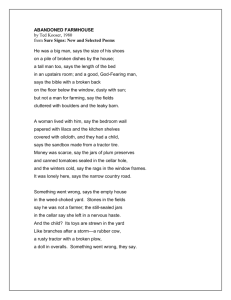abandoned farmhouse analysis
advertisement
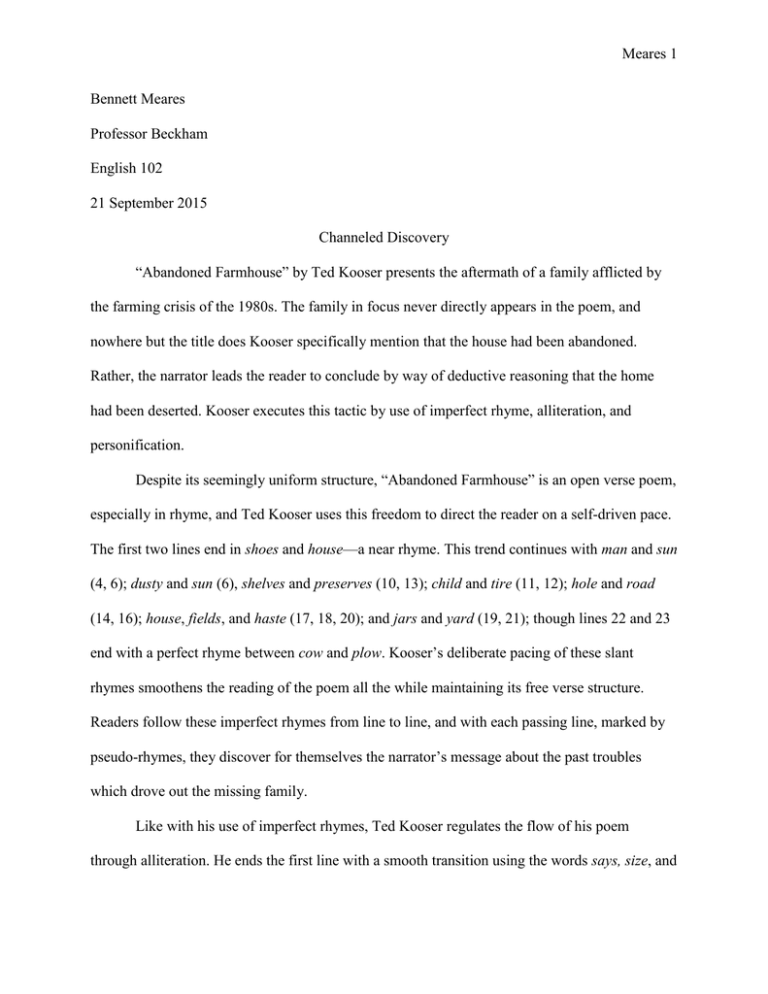
Meares 1 Bennett Meares Professor Beckham English 102 21 September 2015 Channeled Discovery “Abandoned Farmhouse” by Ted Kooser presents the aftermath of a family afflicted by the farming crisis of the 1980s. The family in focus never directly appears in the poem, and nowhere but the title does Kooser specifically mention that the house had been abandoned. Rather, the narrator leads the reader to conclude by way of deductive reasoning that the home had been deserted. Kooser executes this tactic by use of imperfect rhyme, alliteration, and personification. Despite its seemingly uniform structure, “Abandoned Farmhouse” is an open verse poem, especially in rhyme, and Ted Kooser uses this freedom to direct the reader on a self-driven pace. The first two lines end in shoes and house—a near rhyme. This trend continues with man and sun (4, 6); dusty and sun (6), shelves and preserves (10, 13); child and tire (11, 12); hole and road (14, 16); house, fields, and haste (17, 18, 20); and jars and yard (19, 21); though lines 22 and 23 end with a perfect rhyme between cow and plow. Kooser’s deliberate pacing of these slant rhymes smoothens the reading of the poem all the while maintaining its free verse structure. Readers follow these imperfect rhymes from line to line, and with each passing line, marked by pseudo-rhymes, they discover for themselves the narrator’s message about the past troubles which drove out the missing family. Like with his use of imperfect rhymes, Ted Kooser regulates the flow of his poem through alliteration. He ends the first line with a smooth transition using the words says, size, and Meares 2 shoes, and throughout the poem, he uses alliteration in conjunction with near rhymes to slide one line into the next. Kooser uses this approach in phrases such as “good, God-fearing man” (4), “Bible with a broken back” (5), “tractor tire” (12), “plum preserves” (13), “sealed in the cellar” (14), “went wrong” (17, 24), and “still-sealed” (19). Usage of these words is not crucial to communicating the message, but Kooser’s application of this technique strengthens the intensity within readers’ unraveling of the hidden meaning. Alliteration paired with near rhyming rhythmically runs readers into the right resolution, a destination set by use of personification. In “Abandoned Farmhouse,” Ted Kooser best develops the narrator’s perspective through personification. In nearly every line, the speaker feeds bits of information about the family that lived in the home and applies the listed trait to an object on the property. For example, the opening phrase “He was a big man” is immediately attributed to the man’s shoes in the phrase “says the size of his shoes” (1). Kooser brings to life shoes, a bed, a Bible, fields, a bedroom wall, a sandbox, jars, rags, a road, an empty house, and stones by granting these objects human characteristics. Together, these items tell the story of a small, poor family which forsake its agrarian lifestyle. All that remains to signify their past occupancy is the rundown shell of a home, and its contents as well as the surrounding property, once given human qualities, illustrate the family’s struggles and departure. The reader can deduce for himself the family’s plight by processing the perspectives of the personified property, which Kooser aids with rhyme and alliteration. Given that “Abandoned Farmhouse” is largely based upon reader interpretation, there is no clear resolution for the family, though Ted Kooser nudges along readers into the nature of the family’s fate. The tense fear, best expressed in the third stanza, arises from the stories of the objects around the home, and it is the reader’s responsibility to uncover the family’s grim Meares 3 outcome. In total, Ted Kooser leads readers to discover meaning in his poem by use of devices such as imperfect rhyme, alliteration, and personification. Meares 4 Works Cited Kooser, Ted. “Abandoned Farmhouse.” Sure Signs: New and Selected Poems. Pittsburgh: University of Pittsburgh, 1980. N. pag. Print.
